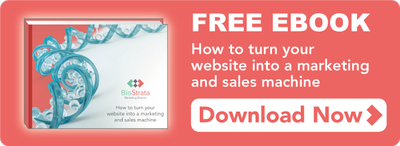Back in 1996 Bill Gates coined the phrase ‘Content is King’ in a feature published on the Microsoft website. The article opened by stating, “Content is where I expect much of the real money will be made on the internet”. Almost 20 years later this sentiment has proven to be a reality. Content is one of the most important aspects of any website and with the rise of inbound marketing, it is at the front of all marketers minds. Great content is the fuel that will drive visitors to your website and turn prospects into leads.
Not every visitor is ready to buy
It can be easy to forget that even though the purpose of a life science marketing website is to provide people with information about your products and services, not everyone will be ready to buy when they arrive on your site. Imagine you are looking to buy a new car. Before a pushy sales man pounces upon you on the forecourt, you will probably want to browse the cars in the showroom, take the brochure home to read, search out some online reviews, and take a test drive. Only then will you feel ready to make the purchase. It is no different for a visitor to your website. You need to demonstrate what’s in it for them and keep them interested.
 Image: Rawpixel/Shutterstock.com
Image: Rawpixel/Shutterstock.com
Create killer content through educating and offering value
It is vital that visitors to your website feel as though they are receiving valuable information and not just a sales pitch. So, how can you do this for a life science marketing website?
1. Offer more than product content
- Case studies: Develop a suite of case studies to show your product/service in action, the challenge that it helped to overcome and the results.
- Video case studies: Film your KOL network and happy customers talking about why they chose to use your product or service and the difference it has made to their working lives.
- Symposia/training presentations: If you are hosting a symposium at an exhibition or training for customers, film it and upload the content to your website.
- Whitepapers/Application notes: Develop whitepapers to sell the business case for your product or service, or application notes to identify the many different applications for your product in the scientific world.
- Press articles: Purchase the rights to publish press articles on your website.
- Infographics: Infographics are a great way to visually illustrate a problem and solution and are often far easier to digest than paragraphs of text. We can show you how to get the most out of your infographic.
- Posters: Publish your posters and peer review papers.
- Podcasts: Consider developing a series of podcasts to address an issue within the life science arena that your product/service specialises in.
- Games: Even though the life science industry may seem serious, it doesn’t mean that those of us working within it aren’t missing the need for entertainment. Consider creating interactive games.
2. Write as if you are speaking directly to your audience
- Use words like ‘you’ and ‘we’ and make yourself sound human.
- Avoid marketing gobbledygook and speak their language.
- Write as if you are helping them solve their problem.
- Avoid language such as ‘we are the best’ and instead use ‘this is how we can help you’.
- Come across as enablers and reassure the visitor that you will be a solid reliable partner.
Your website needs to perform by attracting visitors, educating them and convincing them to buy. These tips will help get you well on the way to creating killer website content to convert visitors into prospects.
You can find out more about website development, design and content by downloading our FREE eBook on turning your website into a marketing and sales machine.





